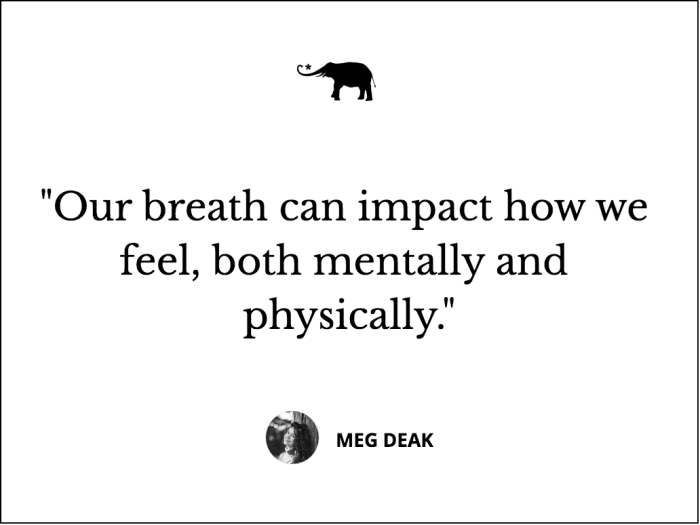View this post on Instagram
The last time you were upset someone might have told you to “just breathe.”
While some people say it to dismiss emotion, there is solid science to back this advice. Changing our breath can change our physiology.
In a heated moment, slowing down our breath can calm us down. Changing our breath has even been related to changing our body temperature. Sound more like a legend than reality?
Here’s the science explaining what’s going on.
Breath and emotion
Recently, I noticed when I’m anxious or in an argument with someone, I tend to hold my breath. I’m not alone in this situation.
According to King’s college hospital, being anxious can make breathlessness worse. A 2019 paper compared breathlessness rates in individuals with and without anxiety and depression. They found a correlation between breathlessness and individuals with anxiety, depression, or both.
“The higher your levels of anxiety, the more you tend to focus on not being able to breathe. This, in turn, makes breathing seem much harder,” they explained in a pamphlet about anxiety and breathing.
People who struggle with anxiety-related disorders, such as panic disorder or obsessive-compulsive disorder (OCD), often have low carbon dioxide levels. They also have a much greater fear of holding their breath. To avoid another panic attack, they may actually breathe too much. This causes hypersensitivity to carbon dioxide. The rise in CO2 gas can increase panic, creating a situation where they’re now anxious because they’re over-breathing, and over-breathing because they’re anxious.
A paper published in the journal of biobehavioural medicine found patients with panic disorder experienced more shortness of breath when anxious.
Your emotional state can dictate where you breathe from, and where you breathe from is important. “Happiness and sadness have a breath pattern in the body,” Marie Bodine, a breath instructor from Toronto, Ontario, explained.
“If you’re breathing from a stress state all the time you’re breathing from your shoulders,” Bodine explained, “Breathing can unlock different emotions. When someone is stressed we tell them to breathe deep for a reason.”
Bodine added knowing how breathing changes the body has huge implications for mental health. Changing our breath has been shown to change our emotional and mental state. There are health-promoting effects of slowing breathing.
For example, slowing breath has been found to decrease mean blood flow, increase vagal activity, and shift the nervous system toward parasympathetic dominance. Some practices focusing on slowing the breath, such as yoga, have become popular.
An article published by Harvard Medical School explained deep breaths from the belly help relax the body and control stress. Breathing deep is a parasympathetic response. When we inhale, our diaphragm lowers and sucks blood into the thoracic cavity. When we exhale, blood shoots back out through our bodies, calming our mental state.
Body temperature
Have you ever stood outside in the winter at the bus stop wishing you could make yourself warm? Well, current research shows using our breath, we might be able to.
There is a good amount of research documenting the impact of certain breathing techniques on body temperature, particularly focusing on the breath in G-tummo meditation.
A 2013 study from the National University of Singapore showed core body temperature can be controlled by the brain. Core body temperature is the temperature of the body’s internal organs. Typically, the body’s core temperature is between 36.5 and 37.4°C.
The study documented core body temperature increases in Tibetan nuns practicing g-tummo meditation. The nuns were able to dry the wet sheets wrapped around their bodies and raise their core body temperature in the cold Himalayas. A follow-up study was conducted with western participants using a breathing technique of the g-tummo meditative practice. They were also able to increase their core body temperature.
The study shows non-meditators can increase their core body temperature using specific breathing techniques. There are two components to g-tummo meditation, g-tummo breathing, and concentration visualization. G-tummo breathing is also known as vase breathing. Vase breathing is a breathing technique that produces heat.
To do vase breathing, breathe in and hold your breath, then contract the pelvic muscles so your belly looks similar to a vase. Hold this for 5-15 seconds. The other part of g-tummo meditation, the visualization, involves imaging flames down the spinal cord to preserve heat.
The study shows we do not have to be a Tibetan monk to reap the benefits of g-tummo meditation. According to Associate Prof Kozhevnikov, non-meditators can use the technique to improve their cognitive performance and regulate their body temperature.
Keep in mind
What science shows so far is the connection between breath and the body’s physiology. Our breath can impact how we feel, both mentally and physically. There are different types of breathing, and everyone will respond a bit differently to them.
“We’re all bringing different experiences to life,” Bodine explained, “Breathing is kind of like exercise, everyone comes to it from a different place.”
~







Read 1 comment and reply